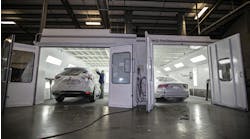Improved bar code systems developed to meet special technical demands of tire industry
After overcoming several technological issues inherent with the intricacies of tire-tracking, a series of bar coding programs and equipment designed specifically for the tire industry has been brought to market by Accu-Sort Systems.
Bar codes are essential for tire manufacturing because they allow the manufacturer to track tires for quality purposes and in case of product recalls, according to product manager Cindy Zeiger. A number of tire manufacturers are now using these bar code reader systems for product sorting prior to shipping, and for reading bar codes at x-ray and balancing test stands.
“Capturing the data on these bar codes is especially challenging because the bar codes are small and located in the bead area of the tire, making it difficult for automated equipment to read. In addition to the need for high read rates, the tire industry also needs to minimize maintenance costs and increase uptime,” she explains. “This new equipment has been successful in this application by addressing all of these customer concerns.”
The tire industry uses low-aspect ratio bar-codes, which range from only 3/8- to ½-inch tall. Often these bar codes have narrow elements (10 mil) that compound the challenge for bar code readers. These bar codes can be in any orientation as the tire passes the scan point. The company has developed three different technical options: A bar code-reading omni-directional laser scanner, an economical bar code-reading camera, and a high-end camera.
To achieve extremely high read rates, some tire plants use the firm’s AV4000 camera bar code reading system. This CCD style camera has the ability to read low-aspect-ratio 1D bar codes and 2D symbologies, which are used on tires at the retail level, says Zeiger. The cameras can also capture images of no-reads for analysis.
The omni-directional laser scanner, called Axiom-X, can take the place of the six to 14 scan heads required by other available technologies, thus increasing reliability by reducing the potential points of failure and making the system easy to install by plant personnel, she notes. In addition, the Axiom-X design simplifies maintenance by allowing hot-swap component change-outs. The system parameters are stored in the scan head and base so there is no need for reconfiguration during swap out.
Also, Zeiger contends, Axiom-X has a higher temperature operation rating than some of the existing systems, an important feature for tire plants, which typically have high indoor temperatures.
The AccuVision HandsFree is a small CCD camera/decoder that can reliably read the smallest low-aspect-ratio bar codes. Providing camera read rates at the price of a laser scanner, it has a deep 30-inch depth of field able to handle tires of different sizes. Like the Axiom-X, the HandsFree can be easily maintained by plant personnel, thus lowering operating costs and minimizing equipment downtime.
Zeiger says this equipment allows users to standardize on a single model reader, reducing stock-room costs with common spares.
For more information, visit www.accusort.com.




